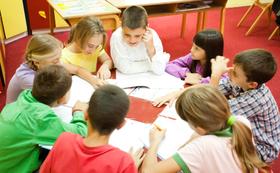For the 2025-26 school year, there are 3 public schools serving 674 students in Kenyon-Wanamingo School District. This district's average testing ranking is 6/10, which is in the top 50% of public schools in Minnesota.
Public Schools in Kenyon-Wanamingo School District have an average math proficiency score of 39% (versus the Minnesota public school average of 46%), and reading proficiency score of 50% (versus the 51% statewide average).
Minority enrollment is 14% of the student body (majority Hispanic), which is less than the Minnesota public school average of 39% (majority Black and Hispanic).
Overview
This School District
This State (MN)
# Schools
3 Schools
2,723 Schools
# Students
674 Students
870,535 Students
# Teachers
40 Teachers
57,764 Teachers
Student-Teacher Ratio
17:1
17:1
Student By Grade
District Rank
Kenyon-Wanamingo School District, which is ranked within the top 50% of all 520 school districts in Minnesota (based off of combined math and reading proficiency testing data) for the 2022-2023 school year.
The school district's graduation rate of 90% has decreased from 95% over five school years.
Overall District Rank
#248 out of 525 school districts
(Top 50%)
(Top 50%)
Math Test Scores (% Proficient)
39%
46%
Reading/Language Arts Test Scores (% Proficient)
49%
51%
Science Test Scores (% Proficient)
49%
41%
Graduation Rate
(21-22)≥90%
84%
Students by Ethnicity:
Diversity Score
0.25
0.59
% American Indian
n/a
2%
% Asian
n/a
7%
% Hispanic
9%
12%
% Black
1%
12%
% White
87%
61%
% Hawaiian
n/a
n/a
% Two or more races
3%
6%
All Ethnic Groups
District Revenue and Spending
The revenue/student of $18,214 is higher than the state median of $17,860. The school district revenue/student has grown by 7% over four school years.
The school district's spending/student of $17,582 is less than the state median of $18,585. The school district spending/student has grown by 7% over four school years.
Total Revenue
$12 MM
$15,547 MM
Spending
$12 MM
$16,179 MM
Revenue / Student
$18,214
$17,860
Spending / Student
$17,582
$18,585
Best Kenyon-Wanamingo School District Public Schools (2025-26)
School
(Math and Reading Proficiency)
(Math and Reading Proficiency)
Location
Quick Facts
Rank: #11.
Kenyon-wanamingo Elementary School
(Math: 65-69% | Reading: 45-49%)
Rank:
Rank:
7/
Top 50%10
225 3rd Ave
Wanamingo, MN 55983
(507) 789-7000
Wanamingo, MN 55983
(507) 789-7000
Gr: PK-4 | 217 students Student-teacher ratio: 16:1 Minority enrollment: 13%
Rank: #22.
Kenyon-wanamingo Middle School
(Math: 33% | Reading: 50%)
Rank:
Rank:
5/
Bottom 50%10
400 6th St
Kenyon, MN 55946
(507) 789-6186
Kenyon, MN 55946
(507) 789-6186
Gr: 5-8 | 216 students Student-teacher ratio: 18:1 Minority enrollment: 13%
Rank: #33.
Kenyon-wanamingo Senior High School
(Math: 11-19% | Reading: 50-59%)
Rank:
Rank:
4/
Bottom 50%10
400 6th St
Kenyon, MN 55946
(507) 789-6186
Kenyon, MN 55946
(507) 789-6186
Gr: 9-12 | 241 students Student-teacher ratio: 17:1 Minority enrollment: 14%
Frequently Asked Questions
How many schools belong to Kenyon-Wanamingo School District?
Kenyon-Wanamingo School District manages 3 public schools serving 674 students.
What is the rank of Kenyon-Wanamingo School District?
Kenyon-Wanamingo School District is ranked #258 out of 520 school districts in Minnesota (top 50%) based off of combined math and reading proficiency testing data for the 2022-2023 school year.
What is the racial composition of students in Kenyon-Wanamingo School District?
87% of Kenyon-Wanamingo School District students are White, 9% of students are Hispanic, 3% of students are Two or more races, and 1% of students are Black.
What is the student/teacher ratio of Kenyon-Wanamingo School District?
Kenyon-Wanamingo School District has a student/teacher ratio of 17:1, which is higher than the Minnesota state average of 15:1.
What is Kenyon-Wanamingo School District's spending/student ratio?
The school district's spending/student of $17,582 is less than the state median of $18,585. The school district spending/student has grown by 7% over four school years.
Recent Articles

School Vouchers: Updated Pros and Cons (2025 Review)
Comprehensive 2025 analysis of school vouchers, weighing benefits and challenges for families, funding, outcomes, and policy directions.

Benefits and Drawbacks of Homework in 2025
Explore updated 2025 insights on homework鈥檚 benefits, drawbacks, mental health impact, best practices, and policy trends in U.S. public schools.

Charter Schools vs Public Schools 2025: Key Differences & Trends
Explore updated 2025 insights comparing charter schools vs public schools, enrollment, academic outcomes, funding, and real-world examples for families and educators.





